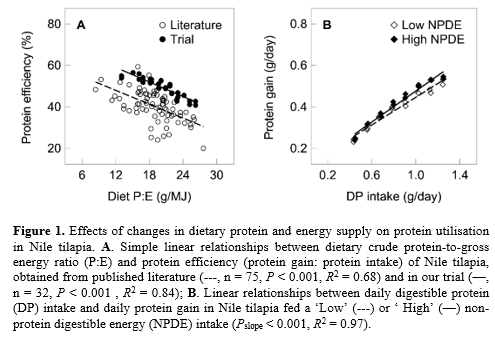THERE IS NO SINGLE OPTIMAL PROTEIN-TO-ENERGY RATIO FOR NILE TILAPIA Oreochromis niloticus FEEDS
Introduction
Protein deposition in fish muscle tissue (i.e. fillet) is an energy-demanding process in which amino acids (i.e. absorbed protein) can act as building blocks or as energy substrates. Because protein is the most expensive macro-nutrient of commercial fish feeds, fish nutritionists intend to maximize the use of amino acids as building blocks instead of energy substrate. This is often achieved by increasing the non-protein energy content of fish feeds via inclusion of lipids and carbohydrates, thereby decreasing the dietary protein-to-energy ratio (P:E). For the sake of feed efficiency, much effort has been dedicated to defining optimal dietary P:E for farmed fish species like Nile tilapia (Oreochromis niloticus)1–3. Yet, published estimates vary largely, with optimal P:E ranging from 16 to 29 g/MJ for Nile tilapia3,4. Most published estimates were determined from feeding trials in which contrasts in dietary P:E were achieved by diluting dietary proteins with lipids and carbohydrates. Often, this has led to simultaneous changes in protein and energy intake, thereby making it impossible to distinguish the separate effects of protein and energy intake on growth. In addition, the emphasis placed on whole body mass gain changes with dietary P:E may have masked more meaningful underlying changes in nutrient partitioning. We conducted a meta-analysis and a dose-response trial to overcome these limitations and determine if there is a single optimal P:E for Nile tilapia feeds.
Material and methods
A systematic literature review was conducted to aggregate published feed, growth and body composition data of Nile tilapia growth trials. A total of 75 cases (i.e. dietary treatments) reported in 11 publications were selected for analysing the effects of dietary P:E on nutrient partitioning. These 75 cases provided data for Nile tilapia ranging from 6 to 250 grams and fed diets varying in crude protein (195 – 565 g/kg of dry matter) and gross energy content (17 – 24 MJ/kg of dry matter). In addition, a dose-response balance trial was conducted with all-male Nile tilapia (initial body mass = 64 g) at the Aquatic Research Facility of Wageningen University (NL) to test the separate effects of protein and non-protein energy intake on nutrient partitioning and growth. The trial consisted of a 2×8 factorial design in which duplicate 60 litres tanks of 30 fish were randomly allocated to one of 2 levels of digestible non-protein energy intake (16.0 and 22.4 kJ/day) and one of 8 levels of digestible protein intake (0.44 – 1.25 g/day). The 32 tanks were individually equipped with a settling faeces collection device and connected to a single recirculating aquaculture system kept at 28°C. Fish were hand-fed restrictively twice a day and faeces were collected overnight. Nutrient apparent digestibility was calculated via the indirect method using yttrium oxide as dietary inert marker. Initial and final body composition were determined from 20 fish and 10 fish/tank, respectively. For all analyses, crude protein was calculated by multiplying the Kjeldhal-analysed N content by 6.25. Growth, feed, faeces and body composition data collected from the literature review and obtained in our balance trial were used to calculate nutrient balances. The effects of changes in dietary P:E and digestible protein and non-protein energy intake on nutrient balances were analysed by linear regression, using SAS software package version 9.4 (SAS Institute Inc., Cary, NC, USA).
Results and discussion
Protein retention efficiency (Fig. 1A) increased linearly with decreasing dietary P:E, thereby illustrating a protein-sparing effect of increasing dietary non-protein energy content. The fact that this effect was linear across a wide range of dietary P:E contradicts the concept of a single optimum in the dietary P:E of Nile tilapia. Protein gain increased close to linearly with digestible protein intake in our dose-response trial (Fig. 1B), with neither the intercept nor the slope being affected by non-protein energy intake level (P = 0.67 and 0.11, respectively). This indicates that protein – and not non-protein energy – intake limited protein deposition throughout the entire range. Again, this contradicts the concept of a single optimal balance between dietary protein and energy intake above and below which protein deposition would be limited by energy and protein, respectively. Instead of a single fixed value, the optimal P:E for Nile tilapia feeds is more likely to reflect situation-specific compromises between dietary protein cost and factors such as constraints on nitrogen discharge, body fat content and fillet yield.
References
1. Kaushik, S. J., Doudet, T., Médale, F., Aguirre, P. & Blanc, D. Protein and energy needs for maintenance and growth of Nile tilapia (Oreochromis niloticus). J. Appl. Ichthyol. 11, 290–296 (1995).
2. El-Sayed, A. F. M. & Teshima, S. I. Protein and energy requirements of Nile tilapia, Oreochromis niloticus, fry. Aquaculture 103, 55–63 (1992).
3. Wang, K.-W., Takeuchi, T. & Watanabe, T. Optimum protein and digestible energy levels in diets for Tilapia nilotica. Bull. - Japanese Soc. Sci. Fish. 51, 141–146 (1985).
4. Sweilum, M. A., Abdella, M. M. & Salah El-Din, S. A. Effect of dietary protein-energy levels and fish initial sizes on growth rate, development and production of Nile tilapia, Oreochromis niloticus L. Aquac. Res. 36, 1414–1421 (2005).
